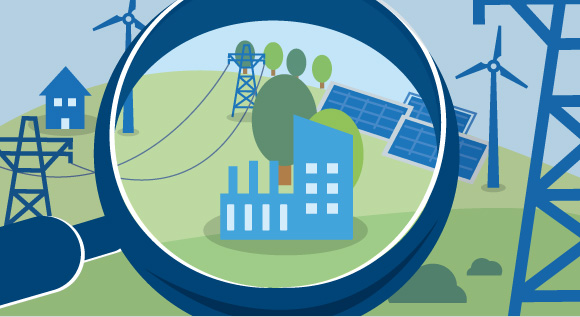What exactly is meant by 'efficiency'?
How much of the energy fed into an installation is converted into energy that can be used? It all depends on the installation's efficiency. You'll find more information here.
 © BMWi
© BMWiIt's about using energy as efficiently as possible
Many of us start the weekend by refuelling the family car to prepare for a trip to the countryside. Unfortunately, the petrol usually won't last for long. Internal combustion engines simply aren't all that efficient, converting a mere 35 per cent of the energy contained in the petrol into kinetic energy. The remaining 65 per cent is turned into waste heat generated in the engine itself and as a result of friction in the powertrain, for instance. All this means that only around 21 litres of the 60 litres you would normally fill your tank with is used for movement.
Diesel engines are slightly more efficient, converting nearly half (45 per cent) of the energy contained in the fuel into kinetic energy. But that's nothing compared to an electric drive. Electric car drives are around 80 to 90 per cent efficient.
Efficiency is the share of the energy fed into the tank or battery that actually makes it to the wheels of the car. Or, if we don't just look at cars anymore, it is the share of the energy fed into a technical installation that can be used for the actual purpose of that installation. Efficiency is expressed as a figure on a scale from 0 to 1 or as a percentage. In reality, however, it can never be as high as 1 or 100 per cent, simply because some energy will always be converted into (waste) heat.
Combined heat and power for excellent performance
Efficiency is also extremely important in the context of power installations. Among the most efficient of them are combined heat and power (CHP) installations. Just like your car, these installations are powered by fuel which is burned to generate kinetic energy. This energy is then converted into electricity, a process that also generates heat. Unlike in a car, however, this heat does not go to waste but is used for heating. This means that the fuel is used to generate both electricity and head, which makes it highly efficient (up to 90 per cent).
Compared to other installations, CHP installations therefore need less fuel to create the same amount of electricity or heat, which also means they cause fewer greenhouse gas emissions (CO2). Modern installations can be powered not only on natural gas, but also biogas, bioethanol or wood, which again translates into lower CO2 emissions.
These properties make CHP a vital element of the energy transition. The share of CHP in Germany's power consumption stood at around a fifth in 2015 and is set to rise further in the coming years. At the same time, we need to find more flexible ways of integrating those CHP installations that are powered by renewables into the heat and electricity market. Both of these objectives are to be served by the auctions that will take place as of 2018.
More efficiency, more funding
The energy transition relies on new, highly efficient technologies for our future energy supply. This is why the German government is promoting research and development in this field. One of its most important tools here is the 6th Energy Research Programme, which supports companies and research establishments in their work to develop new energy technologies. The focus here is on making PV installations, fuel cells, solar thermal installations and other technologies more efficient.

